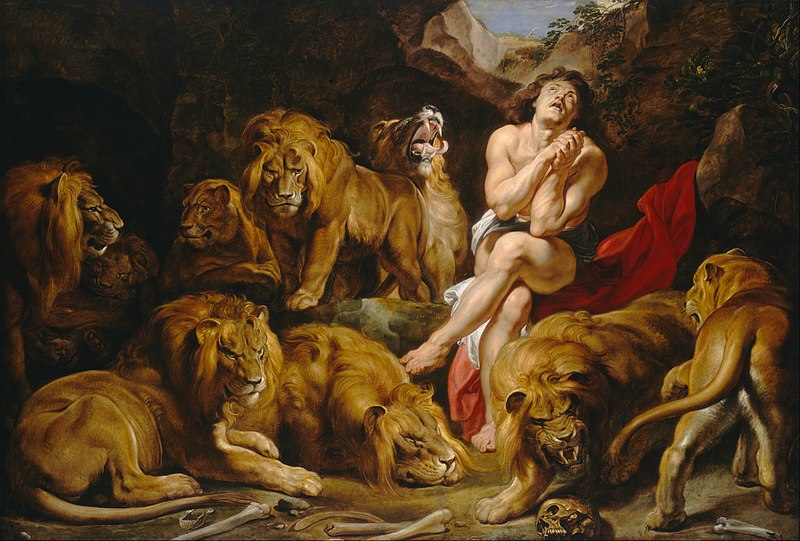We are making BIG changes here on CBN! We have combined the 4 Contributor blogs into the main Catholic Bloggers Network blog. No more posts will be added to this contributor blog. All new posts will be added to the main blog. For more information about this please visit our main blog: HERE.
All contributor bloggers please fill out this form if you wish to continue being a contributor. Thank you.
Please subscribe to the main blog to receive any future posts. Thank you!
Tuesday, September 30, 2014
A biography of St. Therese (and a Kindle bargain)

Note: In celebration of the feast of St. Therese on Wednesday, October 1, the Kindle version of Trusting God with St. Therese is only $.99 until 8 AM Pacific Thursday. This may be the only time I run such a sale, so it’s a great opportunity to pick up a copy if you haven’t already.
St. Therese of Lisieux is one of the most popular saints in history. Almost immediately after her death, her little way of spiritual childhood began to spread. She was canonized less than thirty later and named a Doctor of the Church by Pope John Paul II.
St. Therese’s childhood
Marie-François-Therese Martin was born in Alençon, France in 1873. Her parents were Louis Martin and Marie-Azelie Guerin Martin. She was the youngest of their nine children, four of whom died before age six. Louis and Zelie were committed Catholics. They were standouts even in the Catholic subculture that had grown up in the larger, anti-Catholic culture of their place and time. Both had considered religious life before they met and married. Zelie was a successful businesswoman. Louis eventually sold his business to help with hers.Therese was a talkative, happy, but spoiled child. She had a strong will, but everyone loved her. When Therese was four, Zelie was diagnosed with incurable breast cancer. She died before the year was over. “My happy disposition completely changed after Mama’s death,” Therese later wrote in her autobiography, Story of a Soul. She became shy and extremely sensitive.
Continue reading at Contemplative Homeschool.
Friday, September 26, 2014
Pope Francis Pops the Soap Bubble of Christian Vanity
Pope Francis used his homily during the morning Mass at the Casa Santa Marta to warn Christians against vanity when practicing the faith. The Holy Father keyed off of the scriptural reading from the Book of Ecclesiastes to dwell upon vanity, which the pontiff illustrated through several examples of living to be seen.
Pope Francis emulated the inspiration for his regnal name by railing against doctors of the law who stroll around the square wearing luxurious attire like princes. This certainly sounds like words that could be uttered by St. Francis Assisi.
 |
| Pope Francis celebrating Mass at acro Convento and Saint Francis Basilica in Assisi |
Pope Francis pastorally inspired homilies used tangible metaphors, like soap bubbles and onions, to drive home his point against vanity. But the Holy Father supplemented these symbols with the rich history of the Church.
“The Egyptian Fathers of the desert said that vanity is a temptation against which we must battle our whole life, because it always comes back to take the truth away from us. And in order to understand this they said: It’s like an onion. You take it, and begin to peel it – the onion – and you peel away vanity today, a little bit tomorrow, and your whole life your peeling away vanity in order to overcome it. And at the end you are pleased: I removed the vanity, I peeled the onion, but the odor remains with you on your hand. Let us ask the Lord for the grace to not be vain, to be true, with the truth of reality and of the Gospel.”
The answer from the Holy Father is humility, prayer leading to acts of charity.
h/t Vatican Radio
Tuesday, September 23, 2014
True Contemplation and its Counterfeit
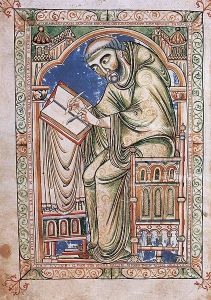 Normally the word contemplation is used to describe the mystical awareness of God's action in a person, working through the Holy Spirit as they are being gradually transformed into the image and likeness of Christ. It begins not when we so choose, but when he chooses. Although we can prepare for it, it is essentially God's gift. To begin with it is often called 'obscure contemplation', or 'the prayer of faith' or a 'ray of darkness'. This is because at first, the action of the Holy Spirit only highlights all that separates us from the transformation into Christ that he is working to achieve. The 'ray of darkness' suddenly becomes a 'ray of light' when God chooses, giving the believer ever deeper experiences of the presence of God within, as the journey into Christ deepens. read more...
Normally the word contemplation is used to describe the mystical awareness of God's action in a person, working through the Holy Spirit as they are being gradually transformed into the image and likeness of Christ. It begins not when we so choose, but when he chooses. Although we can prepare for it, it is essentially God's gift. To begin with it is often called 'obscure contemplation', or 'the prayer of faith' or a 'ray of darkness'. This is because at first, the action of the Holy Spirit only highlights all that separates us from the transformation into Christ that he is working to achieve. The 'ray of darkness' suddenly becomes a 'ray of light' when God chooses, giving the believer ever deeper experiences of the presence of God within, as the journey into Christ deepens. read more...
Friday, September 5, 2014
Should we sit quietly during prayer?
 |
| A Hermit Praying in the Ruins of a Roman Temple by Hubert Robert |
Last week I wrote about St. Teresa’s of Avila’s method of mental prayer. Today I want to discuss misunderstandings about prayer from a different angle. Since we desire contemplation, should we sit still in prayer and wait for it? Should we try to make it happen by quieting our minds? Like last Friday’s post, this series speaks to the differences between Carmelite teaching and Centering Prayer, yoga, and other types of meditation influenced by eastern religions.
Some people falsely equate silence with supernatural (infused) contemplation. They read about the need for interior silence in prayer, and they mistakenly think that if they sit quietly, God will necessarily bestow contemplation upon them. They equate the peace they find in silence to communion with God.
The Vatican has cautioned us about certain methods of prayer
In 1989, Cardinal Joseph Ratzinger (later Pope Benedict XVI), as head of the Congregation for the Doctrine of the Faith, wrote Letter to the Bishops of the Catholic Church on Some Aspects of Christian Meditation. Here is what the document says about silence:Similar methods of meditation, on the other hand, including those which have their starting-point in the words and deeds of Jesus, try as far as possible to put aside everything that is worldly, sense perceptible or conceptually limited. It is thus an attempt to ascend to or immerse oneself in the sphere of the divine, which, as such, is neither terrestrial, sense-perceptible nor capable of conceptualization.” (11)
Continue reading at Contemplative Homeschool.
Friday, August 29, 2014
Did Teresa of Avila teach Centering Prayer?
 |
| St. Teresa's Transverberation by Joefa de Obidos (Wikimedia Commons) |
Last winter on social media, I came across another Catholic author who was promoting yoga. Not as an exercise program, but for spiritual growth. I was shocked. I asked her why she wasn’t promoting prayer instead. She answered, “Meditation is prayer!”
Nope.
Two months ago, my brother forwarded an email from a colleague, asking about Centering Prayer. A friend was pushing it relentlessly. I looked at the website of the Catholic group that promotes Centering Prayer and found this in the FAQs:
This form of prayer was first practiced and taught by the Desert Fathers of Egypt … the Carmelites St. Teresa of Avila, St. John of the Cross and St. Therese of Lisieux…
Nonsense.
The other day a new reader asked in the comments about meditating on Sacred Scripture. “Is this the same as the method of Fr. John Main, who has adapted an Eastern mantra method for Christian meditation?”
Uh-uh.
I have written a little on this topic before, but I think it’s time to revisit it. Let’s start with Teresa of Avila.
Continue reading at Connie's blog Contemplative Homeschool.
Friday, August 8, 2014
How to suffer like a Christan

Suffering. Ever since the Fall of Adam, it’s an unavoidable part of life. We suffer daily in little ways. The alarm clock rings too early. We spill coffee all over our work clothes. The kids are disobedient. We get stuck in traffic. These little things are a reminder that all is not right with the world. Something is out of whack. We have lost the close connection with God we were meant to have.
When we face small trials, we have an opportunity to grow in trust and love. We can offer our disappointments and dislikes to God in love, asking Him to use them to bring others to Him. We can say, “Jesus, I trust in you,” praying that He helps us to accept His sovereignty over our day. Because after all, we were never meant to be in charge of our life. These gentle reminders of that fact can help us reorient ourselves towards God. (As an aside, I am experiencing a little annoyance right now from my kids. Thank you, Lord, for this opportunity to put into practice what I am preaching!)
What about tragedies?
Every day on FaceBook, someone asks me for prayers. Sometimes, a loved one is seriously ill. Other times, a FaceBook friend faces clinical depression. Prayers for difficult pregnancies and comfort while burying infants or dealing with miscarriage are common.How should a Christian face tragic suffering?
Continue reading at Contemplative Homeschool.
Friday, July 25, 2014
In the spirit of Elijah

In the past week we’ve celebrated two major Carmelite feasts: Our Lady of Mt. Carmel (July 16) and the prophet Elijah (July 20). These two great saints in different ways exemplify what Carmelite spirituality is about.
Elijah demonstrates the prophetic aspect of Carmelite spirituality. The Carmelite seal bears these words of his as a motto:
With zeal have I been zealous for the Lord God of Hosts (1 Kings 19:10).
Consumed with zeal for holiness
Elijah was not afraid to confront the rulers of his day. He risked death to preach repentance to King Ahab, while Queen Jezebel launched an anti-crusade to wipe out God’s prophets. He challenged the prophets of Baal to a contest on Mt. Carmel to see whose god would consume a sacrifice with fire from Heaven. After winning that contest (surprise!), Elijah had all the false prophets killed. He led the people to re-commit themselves to the true God.Then he went and prayed that, seeing their repentance, God would send rain. Elijah’s prayers had kept the land in drought for three years.
So Ahab went up to eat and to drink. And Eli′jah went up to the top of Carmel; and he bowed himself down upon the earth, and put his face between his knees. And he said to his servant, “Go up now, look toward the sea.” And he went up and looked, and said, “There is nothing.” And he said, “Go again seven times.”And at the seventh time he said, “Behold, a little cloud like a man’s hand is rising out of the sea.” And he said, “Go up, say to Ahab, ‘Prepare your chariot and go down, lest the rain stop you.’” And in a little while the heavens grew black with clouds and wind, and there was a great rain. And Ahab rode and went to Jezreel. (1 Kings 18:42-45)Since medieval times, Carmelites have seen the cloud as a symbol of Mary. She rises from the sea of our fallen humanity, a human being herself, yet without the stain of sin. She pours down on God’s people the pure water of His grace from Heaven. So the return of rain to the land of Israel is also a prophecy of the Woman whose cooperation with God’s grace will bring about the Incarnation.
Here are some more facts about Elijah:
- His name means, “Yahweh is God.”
- He heard God speak to him in a gentle whisper (or “still, small voice”).
- He nearly despaired because he thought he was the last surviving faithful Israelite.
- He said, “The Lord my God lives, in whose presence I stand” (1 Kings 18:15).
- He raised a boy from the dead.
- He was taken up to Heaven in a chariot of fire.
Continue reading at Contemplative Homeschool.
Monday, July 21, 2014
Mystical Marriage
Some years ago I had lunch with friends in London. On my way out they introduced me to their father who was busy working in the garden. Without thinking I asked him what he was doing and he replied –“I do be digging the garden.” Some months later I met a nun who taught Irish in Dublin and I asked her about this expression that I’d never come across before. She explained that it was an English translation of what in Irish is called the present continuing tense. “Well what does it mean?” I asked, “What was he trying to say to me?” “Oh, what he was saying was this.” she said. “I have been digging the garden, I am digging the garden, and when you stop asking the obvious, I will continue digging the garden!” read on...
A Bit On ISIS Marking Christians for Extermination and Expropriation in Iraq
As jihadist Sunni Islamist terrorists from ISIS/ISIL strive to create a sharia inspired Caliphate as they take over territory in Iraq and Syria, they are slaughtering innocent Christians.
However, even sharia law allows for dhimmitude, second class citizen status for "people of the book" (i.e. Jews and Christians) so long as they pay the jizya tax. But that is not good enough for ISIS jihadists. They have taken to mark the buildings of Christian institutions with spray-painted red marks indicating holdouts to exterminate and expropriate.
 |
| Spraypainted ISIS Extermination Graffiti on Christian buildings in Mosel, Iraq |
 |
| "Nun" 14th letter in Arabic alphabet |
SEE MORE at DC-LausDeo.US
Friday, July 18, 2014
Are your fears, doubts, and frustrations keeping you from intimacy with God?

How is your spiritual life going? Are you feeling frustrated with yourself? Are you distraught over your lack of progress? Do you keep falling into the same sins repeatedly?
Welcome to the human race!
No, I’m not trying to dismiss your concerns flippantly. Sometimes we just need a reminder that we are, after all, fallen. Adam’s sin affects us all. But here’s something you may not have realized:
Your sins do not shock God!
God is used to sinners. He has centuries of experience with them. He even came down from Heaven to live among them. Then people criticized Him for eating with sinners instead of the “righteous.” Yes, He loved to hang out with people like you and me.
God delights in showing mercy. He delights in lifting our burdens. He delights in carrying our yoke with us, comforting our sorrows, calming our fears.
Continue reading at Contemplative Homeschool.
Wednesday, July 16, 2014
Win a signed print copy of Trusting God with St. Therese!
Ladies and Gentlemen, this is the day! Happy Feast of Our Lady of Mt. Carmel. Trusting God with St. Therese is now available on Amazon for the Kindle and in print. For the time being (at least the next 90 days) the ebook will be exclusive to Amazon. However, the paperback should be available soon at Barnes and Noble and other online retailers. I hope to see it in some Catholic bookstores as well. And those of you who are local or who know me personally are always welcome to purchase the paperback directly from me as well.
The last 14 months writing and publishing this book have been busy but rewarding. I pray you will find them rewarding for you too. I really believe it will help almost everyone but those very advanced in the spiritual life to come closer to Christ.
Now for the fun stuff!
Visit Contemplative Homeschool to enter the contest and see the other contests and events marking the release of Trusting God with St. Therese.
Tuesday, July 8, 2014
Helping your choleric child grow in holiness
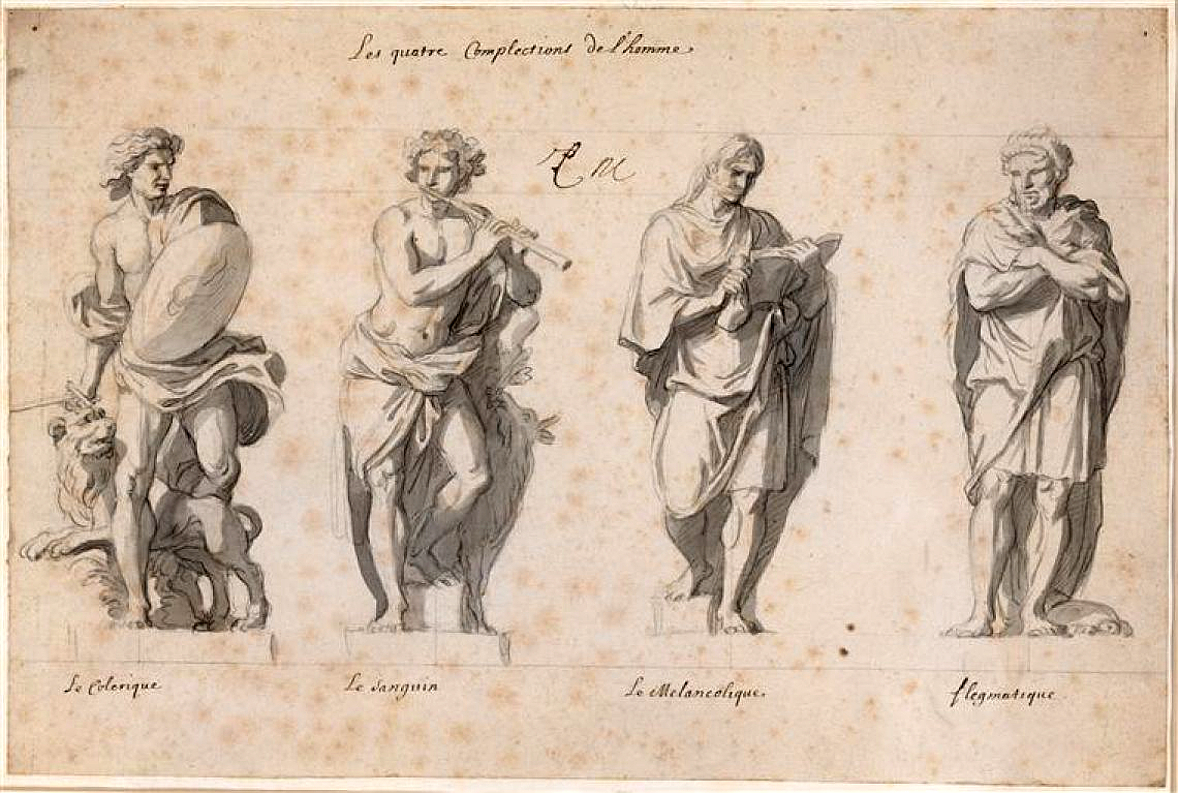
Today I’m taking a break from talking about
my book to return to the new project I’ve talked about a little
before–making a spiritual growth plan for children of each temperament.
First I’ll give a little overview of the four classic temperaments, tell
you a little more about this project, then delve in deeper to help you
with your choleric children. At the bottom you’ll find a special
download to help you.
What are the four temperaments?
The four classic temperaments are choleric, melancholic, phlegmatic, and sanguine. Catholic philosophers adpoted them from the Greeks. There are several good sources for learning about the temperaments from a Catholic perspective. Art and Laraine Bennett have written several books on the temperaments. Fr. Conrad Hock’s treatment of the temperaments can be read online. Traditional books on spiritual direction usually address the temperaments as well.To figure out which temperament you have, ask yourself two questions:
- Are my initial reactions to stimuli intense or dull?
- Do my impressions last or do they quickly fade?
Intense & lasting=choleric
Intense & fading=sanguine
Dull but lasting=melancholic
Dull and fading=phlegmatic
Continue reading at Contemplative Homeschool.
Tuesday, June 24, 2014
You're more like St. Therese than you think

Do you think you have little in common with St. Therese? Think again.
If I’ve learned anything in writing Trusting God with St. Therese, it’s how much Therese’s struggles were like mine. Consider these points:
- Therese was born weakened by Original Sin.
- It took her years of grace and hard work to overcome family tragedy.
- She had difficulties relating to other children at school.
- She suffered from scruples.
- God repeatedly made her wait for things she believed were His will.
- Her family members misunderstood her spirituality.
- She felt natural aversion to people with difficult personalities.
- She feared losing her remaining loved ones.
- Spiritual darkness and dryness in prayer were her norm.
- Great deeds for God were beyond her capability.
- She suffered terrible pain.
- She was tempted to despair.
Think you can’t become a saint? Think again.
Therese believed in the same God you do. He was her strength and her righteousness. He can be yours as well.
Connie Rossini blogs at Contemplative Homeschool.
Tuesday, June 17, 2014
Fleeing temptations from the world
 |
| The Renunciation of Worldly Goods by Ghirlandaio. |
Over the past few weeks, we’ve been considering the sources of temptations and how to overcome them. We complete the series today by pondering how to flee temptations coming to us from the world.
As we saw earlier, when we speak of “the world” in the context of temptations, we don’t mean the created world. Everything God created is good if used correctly. The problem is, when we lost our proper relationship with God in Adam’s sin, we also lost our proper relationship with one another and with creation.
“The world” is the society that delights in pleasure more than it delights in God. The world entices us to join in the “fun.”
The world values pleasure, power, violence, wealth, fame, and comfort. It does not stop at tempting us. When we resist, it mocks and persecutes us. The world cannot stand to be rejected, having the fury of the proverbial scorned woman.
The world exalts the lowest things to the highest stature. Its motto is “sex, drugs, and rock and roll.” It uses crude, vulgar, and blasphemous language without a second thought. It enshrines these values in book, magazines, TV, and movies. Ancient Rome’s coliseums and circuses exemplified the depths the world can sink to.
Continue reading at Contemplative Homeschool.
Tuesday, June 10, 2014
A sad anniversary and a free chapter of Trusting God with St. Therese
 |
| This is my family (plus two friends) on June 10, 1974. I’m the one with the braids in the front. Terri is behind me next to our mom. |
 |
| Here is how our car looked thirty minutes later. |
Today is the fortieth anniversary of one of the saddest events in my life so far. On June 10, 1974, our family was driving to the annual Catholic Charismatic Conference at the University of Notre Dame. We began our journey in Spokane, Washington, where we had spent a weekend on retreat. Just outside Missoula, Montana, the car rolled over three times, landing in the median of the freeway. I was in the back with the seat down and no seat belt. So were two of my siblings and two friends.
I ended up with stitches in my leg and a bump on my head. My sister Terri, who had been sitting next to me, was thrown from the car and died. She was ten years old.
Why did God let this happen? Didn’t He know where we had come from and where we were going? Hadn’t He heard Terri’s voice, when she had volunteered that morning to pray for a safe trip?
Continue to Connie's blog to receive a free chapter of Trusting God with St. Therese.
Friday, June 6, 2014
The Prayer that Jesus learned
The first prayer that Jesus would have learnt from his mother, like all other Jewish children, was called the ‘Shema Israel, part act of faith, part prayer. Its first words proclaimed belief in the One God who should be loved ‘with the whole heart and mind and with one’s whole strength’. This embodied the essence of Jewish wisdom that Jesus had come to bring to perfection. The ‘Shema’ was the first prayer to be said on the Sabbath in the synagogue where it was also said three times a day to coincide with the sacrifices made in the Temple. For those who were unable to go to the Synagogue, it was said at work, in the fields, or at home, so that the whole day would be dedicated to the love of God. more
from David
from David
Tuesday, June 3, 2014
Battling the temptations of the flesh
 |
| Allegory of Virtues and Vices |
We’ve been delving into temptations coming from the world, the flesh, and the Devil. Last week we discussed demonic temptations in detail. Today, we’ll examine temptations of the flesh and how to combat them.
We saw that people with melancholic or choleric temperaments tend to be more prone to the temptations that come directly from the Devil: pride, envy, and anger. Temptations of the flesh particularly plague the other two temperaments. More specifically, sanguines often struggle with gluttony and sins against chastity. Phlegmatics struggle with sloth. (I will be writing more about the four classic temperaments throughout this year. I am creating a spiritual growth plan for you to use with your children of each temperament.)
As I have said before, the flesh can be the most relentless of the three sources of temptation. While the Devil may leave us alone for a time, and we can shut out the world to a certain extent, we can never get away from our own flesh. It remains with us every moment until the end of our life, but we can learn to resist it.
Gluttony, lust, and sloth
The Catechism defines concupiscence as “the movement of the sensitive appetite contrary to the operation of the human reason… Concupiscence stems from the disobedience of the first sin. It unsettles man’s moral faculties and, without being in itself an offense, inclines man to commit sins” (2515).Sanguines are easily moved by what they experience through their exterior senses. Thus, immodest entertainment might lead them into sexual sin. An all-you-can-eat buffet might tempt them towards gluttony. They might start using vulgar and blasphemous language if they listen to the wrong kind of music.
Continue reading at Contemplative Homeschool.
Tuesday, May 27, 2014
How to overcome the Devil’s temptation
 |
| Dante's Inferno, Canto 8 by William Blake (Wikimedia Commons). |
Last week I wrote about the three sources of temptation. Now let’s look at temptation by the Devil in more detail.
Two Scripture passages show us how the Devil tempts us. Genesis 3 tells how Adam and Eve gave in to temptation and sinned. Matthew 4 tells how Jesus resisted the Devil’s temptation. The two stories contain striking similarities.
The lust of the flesh, the lust of the eyes, and the pride of life
When the Devil tempted Eve, the first thing she noticed was that the forbidden fruit was “good for food” (Gen 3:6). Similarly, the Devil first tempted Jesus by telling Him to turn stones into bread (Mt 4:3). So we see that the Devil often begins by appealing to our natural appetites. In fact, he tempts us with the desires of the flesh.Apparently, Eve was not completely swayed by this temptation, for she also noticed that the fruit was “a delight to the eyes.” Catholic tradition equates this delight with greed–the desire to have something that is not rightly ours, or to have it in overabundance, or otherwise outside of God’s will. Matthew’s Gospel sets this as Jesus’ third temptation. The Devil promised Jesus all the kingdoms of the world for the “small” price of worshiping him. It’s easy to see how this corresponds to temptation by the world.
Continue reading at Contemplative Homeschool.
Wednesday, May 14, 2014
Repentance
Our Father - Repentance
On the feast of Pentecost the Jews celebrated the day on which God had given the Law to Moses. However the first Pentecost after the Resurrection was the day on which God gave his new law - the law of love. This law was not primarily a list of rules and regulations like the laws that were given to Moses, but the same personal love that God had showered on Jesus. It was this love that enabled Jesus to practise to perfection the New Commandments that he taught his disciples. Namely, to Love God with their whole hearts and minds, and with their whole being, as he did, and to love others as he did too, and still does. read on
Tuesday, May 13, 2014
Becoming your children's spiritual director
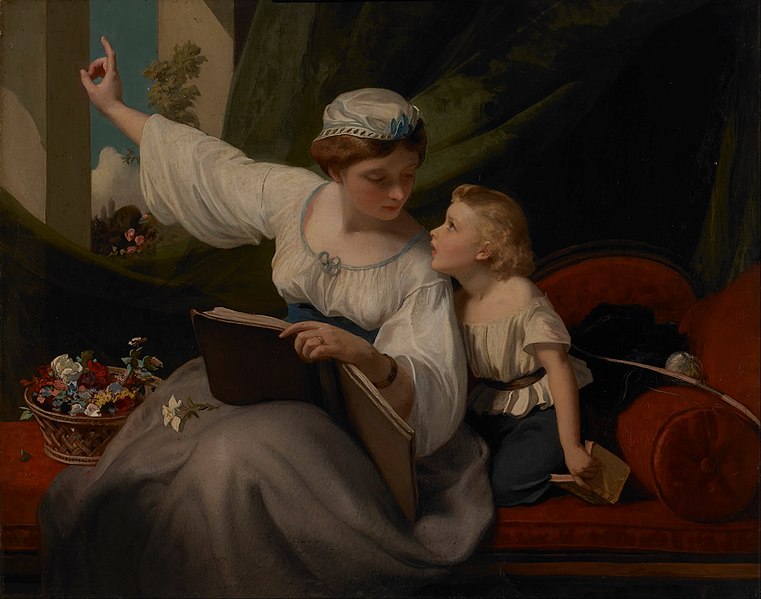
Have you ever thought of having a spiritual director for your kids or grandkids? Have you ever thought of being one? It’s not enough to teach children “religion”–i.e., Catechism. We also need to teach them how to become saints.
I am developing a spiritual growth plan for my three older children. (J is a little too young at age three!) Here are the areas I am considering:
Temperament
D is almost purely choleric, M is melancholic-phlegmatic, and C is primarily phlegmatic. (I haven’t completely figured him out yet–he’s eight and doesn’t know himself as well as the others do.)Each of the four classical temperaments has a different perspective on life. Each has typical strengths and weaknesses. I seek to encourage my boys in their strengths and help them fight their weaknesses. I plan to do much of this through reading. Books will inspire them where lectures won’t.
Talents and interests
Temperament is only one part of personality. Each child has unique talents. For example, cholerics are bursting with energy, but one may be good at football and another at track.Quiet and reserved M has a surprising acting ability.
How can my children use their gifts to glorify God? How can their talents help them choose a vocation and a career?
Continue reading at Contemplative Homeschool.
Friday, May 9, 2014
Church Authority
The authority of the Church, which was once accepted by the churched and respected by the secular, is in modern times no longer a means through which our belief system can be argued or upheld. This sad reality, while a cause for dismay, is also an opportunity for expansion of pedagogical and catechetical methods.
However, this expansion can not come at the price of the recognition that our beliefs stem not from our own intellect, as a sort of series of philosophical conclusions about how to live that were constructed by a group of 12 disciples some 2,000 years ago, but from the Church as guided by the Holy Spirit and led on earth by the Pope. As the noted communications mantra goes, “The medium is the message.”
This is why methods of teaching and conversion that do not ultimately stem from a belief in the magisterium, or teaching authority, of the Church are limited in scope. For example we as Catholics can point to Aristotle’s reason-based arguments for the existence of God, but we can not talk about God as Trinity without citing Christ’s teachings and the theology developed by the Church over thousands of years. The Church guards and passes on the deposit of faith given by Christ.
To believe in the authority of the Church, you see, is simultaneously to believe in Him who formed it, namely Christ. We must then ask ourselves rhetorically: why would Christ form the Church without equipping it with the means (councils, the Papacy, tradition, scripture, etc.) to construct correct dogma? And so to follow church authority means to believe in all of its teachings on faith and morals. This does not entail a blind faith that accepts a series of teachings simply because “Father ‘John Smith’ said so.” In praying each week in the Creed that we “believe in one, holy, catholic and apostolic Church,” we are instead embracing theology arrived at via reason and based upon the premises of faith.
Ryan Bilodeau
Prayer to Pen
Wednesday, May 7, 2014
You can make someone else’s suffering meaningful
 |
| Self Portrait with a Friend by Rafael. |
In the middle of Lent, I received an email from a new reader I’ll call Jill. Jill shared with me her years of darkness in her personal and spiritual life. My heart went out to her. I wanted to do something for her, more than just writing an encouraging answer. So I thought about it and prayed about it. Then I had an insight.
Here, in part, is how I replied:
“I explore these questions [about God and suffering] a lot in my book. I will give you a brief version here. Rabbi Kushner, writing in When Bad Things Happen to Good People, said that we shouldn’t ask why when we suffer. Instead, we should ask, What now? How am I to react?
Finding meaning in our suffering
“Similarly, Holocaust survivor Victor Frankl, author of Man’s Search for Meaning wrote, “Suffering ceases to be suffering in some way in the moment that it finds a meaning.” He found that in the concentration camp, those who were able to survive and be psychologically sound found a purpose in their suffering. For Frankl himself, that purpose was to rewrite the manuscript of his book on helping his psychiatric patients find meaning in life. The Nazis had destroyed his manuscript when he was stripped of his possessions at the camp. So over the years he rewrote the manuscript, partly in his head and partly on any strips of paper he could find. He had the will to survive so he could publish his work…“My question for your situation then was, How can your suffering become purposeful? Some people would counsel you to offer up your suffering. But if you are unable to complete even small projects because your darkness has sapped all your energy, offering it up may just be beyond your strength. What then?
Continue reading at Contemplative Homeschool.
Sunday, May 4, 2014
Holy Communion
As a person tries to observe the new commandments by making acts of love through all they say and do, they are gradually able to rise step by step towards journey’s end. Their progress is made possible, because it is made in, with, and through Christ who claimed to be the vital living embodiment of Jacob’s mystical ladder (John1:51). He is The Way, The Truth, and The Life (Jn 14:6). He is the way to our destination, the Truth who both reveals and embodies that destination, and the eternal life that constitutes that destination.
The journey stretches from here to eternity where the traveller finally enters into a profound and ongoing Holy Communion with the One who dwells in the eternal ecstatic joy, that flows from the mystical vortex of loving that constitutes God’s very being. read on
David's webpage
Wednesday, April 30, 2014
Thanksgiving
Continuing the theme: - Praying the Our Father -
My earliest and happiest memories are of going to visit my grandfather. It wasn’t because he played games with me, gave me my favourite chocolate or even money to buy myself an ice cream on the way home, it was just because I loved him. He was such a lovable kindly man that it was more than enough just to be with him and feel myself enveloped by his love. This was before I even went to prep school. read on....
http://davidtorkington.wordpress.com
http://www.davidtorkington.com
My earliest and happiest memories are of going to visit my grandfather. It wasn’t because he played games with me, gave me my favourite chocolate or even money to buy myself an ice cream on the way home, it was just because I loved him. He was such a lovable kindly man that it was more than enough just to be with him and feel myself enveloped by his love. This was before I even went to prep school. read on....
http://davidtorkington.wordpress.com
http://www.davidtorkington.com
Friday, April 25, 2014
Some Consideration of the Heroic Virtues of Pope St. John Paul II
At his funeral in St. Peter's Square in 2005, there were prolonged chants from the multitude gathered for “Santo Subito” (Sainthood Now!). On April 27, 2014, the Catholic Church celebrated the canonization of the 264th pontiff Pope St. John Paul II (born Karol Józef Wojtyła) along with the 262nd Vicar of Christ Pope St. John XXIII (ne Angelo Giuseppe Roncalli) in St. Peter's Square in Vatican City.
 |
| Three American Presidents paying respects to Pope John Paul II, April 2005 |
Some Protestants bristle at the notion that the Church “makes” saints, as nobody (but Christ) is perfect and that we are all supposed to be called to sainthood in our Christian identity. Certainly our baptism marks us as part of the Lord’s people and calls us to holiness. The Catholic Church can recognize, based on investigation and guidance from the Holy Spirit, that a person is already a saint, definitely in heaven and having led a life of great holiness that is worthy of veneration by the faithful. Canonized
saints are important examples to the faithful of how to live a heroic (not perfect) Christian life.
Pope John Paul II was a remarkable man who wore many hats in his life. He was a Laborer, Thespian, Playwright, Patriot, Priest, Philologist, Philosopher, Pilgrim, Bishop, Theologian, Sportsman, Scholar, Statesman and Vicar of Christ. The cause for John Paul II's canonization however is not premised on doctrinal dissertations, academic accolades or even geopolitical accomplishments.
It is about how John Paul II lived his life to reflect the Christian virtue which still touches the faithful today.
After several years of investigation led by postulator Monsignor Slawomir Oder, the Vatican’s Congregation for the Causes of Saints recommended Servant of God John Paul II’s heroic virtue to the Pope. On December 19, 2009, Pope Benedict XVI proclaimed John Paul II as “Venerable”. The Church normally requires that one miracle is attributable to intercessions of a Venerable, but the Vatican only investigates possible miracles after a candidate is declared Venerable. These miracles are almost always miraculous medical cures as these are the easiest to verify.
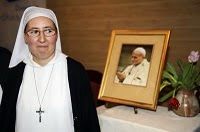 |
| Sr. Marie Simon Pierre |
[***]
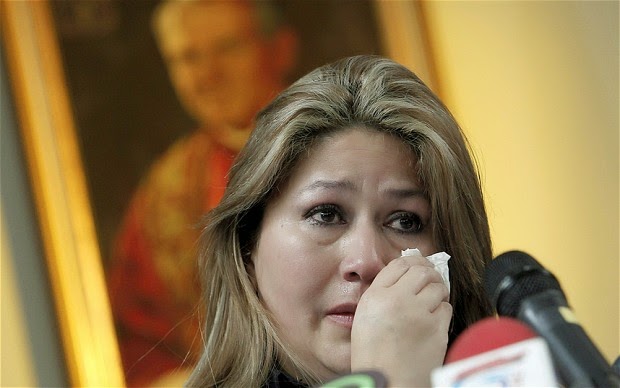 |
| Floribeth Mora Diaz |
[***]
The date of the canonization may well have been chosen because it was the 2nd Sunday of Easter, which Pope John Paul II instituted during his Papacy as “Divine Mercy Sunday”, due to his Devotion to St. Faustina Kowalska (1905-1938). The vigil mass of the feast of Divine Mercy had just been celebrated at John Paul II’s bedside when he fell into a coma and soon after died.
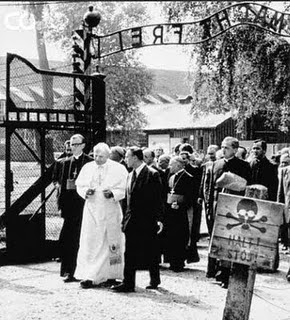 |
| Pope John Paul II at Auschwitz (1979) |
[***]
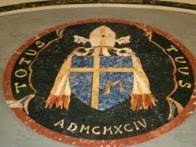 Then Cardinal Karol Wojtyła was elected Pontiff in October 1977 during the Year of Three Popes. While Pope John Paul II was the first non-Italian pope in 454 years and was from a nation behind the Iron Curtain, he was chosen because of his theology. John Paul II chose as his papal motto “Totus Tuus”, which reflected his Reflected his personal consecration to Mary which was based on the spiritual approach of St. Louis de Montfort (1673-1716)—“Totus
tuus ego sum, et omnia mea tua sunt" ("I am all yours, and all that I have is yours"). In Crossing the Threshold of Hope, he explained that the “Totus Tuus” motto expressed the understanding that he “[c]ould not exclude the Lord's Mother from my life without neglecting the will of God-Trinity”. Polish born composer Henryk Gorecki (1933-2010) wrote the choral
piece “TotusTuus” in honor of Pope John Paul II’s 3rd visit to Poland in 1987.
Then Cardinal Karol Wojtyła was elected Pontiff in October 1977 during the Year of Three Popes. While Pope John Paul II was the first non-Italian pope in 454 years and was from a nation behind the Iron Curtain, he was chosen because of his theology. John Paul II chose as his papal motto “Totus Tuus”, which reflected his Reflected his personal consecration to Mary which was based on the spiritual approach of St. Louis de Montfort (1673-1716)—“Totus
tuus ego sum, et omnia mea tua sunt" ("I am all yours, and all that I have is yours"). In Crossing the Threshold of Hope, he explained that the “Totus Tuus” motto expressed the understanding that he “[c]ould not exclude the Lord's Mother from my life without neglecting the will of God-Trinity”. Polish born composer Henryk Gorecki (1933-2010) wrote the choral
piece “TotusTuus” in honor of Pope John Paul II’s 3rd visit to Poland in 1987.
From the start of his Petrine ministry until his eventual death from Parkinson’s Disease 26 ½ years later, John Paul II’s message to the faithful was the Lucan exhortation “Be not afraid”. In fact, John Paul II uttered the phrase three times during his homily at the Papal Inauguration. This message “Be not afraid… open the door wide to Christ” was chosen as the slogan for his beatification.
It was the same message that he brought when he first visited his homeland of Poland in June 1979. The documentary Nine Days That Changed the World showed the power that John Paul II message of “Be not afraid” had with the Polish people to instill the dignity of the individual to live out their faith and, with the guidance of the Holy Spirit, renew the face of the Earth and their land.
It was the same message that he brought when he first visited his homeland of Poland in June 1979. The documentary Nine Days That Changed the World showed the power that John Paul II message of “Be not afraid” had with the Polish people to instill the dignity of the individual to live out their faith and, with the guidance of the Holy Spirit, renew the face of the Earth and their land.
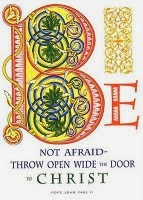 The millions of Poles who flocked to their favorite son's first pilgrimage back to his homeland showed that the faithful were not alone in that officially atheistic state and served as a real retort to Stalin’s taunt of “The Pope! How man divisions does he got?" Both Lech Walesa, the piously Catholic worker who lead
the Solidarity movement (and eventually became Poland’s President), and Vaclav Havel, the less spiritual leader of a free Czechoslovakia, credit the fall of the Iron Curtain to the message “Be not afraid” embodied in John Paul II’s 1st visit to Poland.
The millions of Poles who flocked to their favorite son's first pilgrimage back to his homeland showed that the faithful were not alone in that officially atheistic state and served as a real retort to Stalin’s taunt of “The Pope! How man divisions does he got?" Both Lech Walesa, the piously Catholic worker who lead
the Solidarity movement (and eventually became Poland’s President), and Vaclav Havel, the less spiritual leader of a free Czechoslovakia, credit the fall of the Iron Curtain to the message “Be not afraid” embodied in John Paul II’s 1st visit to Poland.
On May 13, 1981, Pope John Paul II was shot four times at close range and critically wounded in St. Peter’s Square by Mehmet Ali Ağca, a trained Turkish gunman. Many belief that this assassination attempt was a hit job coordinated by the Bulgarian
Secret Police with the complicity of the Kremlin. Yet less than two and a half years later, John Paul II met with Mehmet Ali Ağca and forgave the gunman on Christmas, 1983.
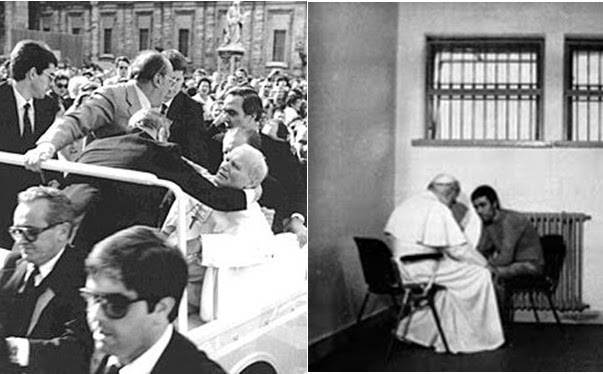 |
| [L] Pope John Paul II shot May 13, 1981, [R] Pope forgives Agca December 25, 1983 |
Pope St . John Paul II was convinced that Our Lady of Fatima kept him alive during the ordeal where he lost 3/4ths of his blood.
The Third Secret of our Lady of Fatima can be seen as predicting the assassination attempt on the Pope. The John Paul II’s
faith filled connection between his assassination attempt and the visions of Fatima that a bullet from his wounds now tops the golden finery of the Our Lady of Fatima processional statue.
One of the hallmarks of Pope St. John Paul II’s reign was being a Pilgrim as Vicar of Christ to proclaim Jesus as the Redeemer of Humanity to all the Earth. Frankly, he came pretty close to covering it all. It is speculated that the curia spent about a fourth of their time planning for and executing his 104 foreign trips to 125 countries which totaled 725,000 miles.
[***]
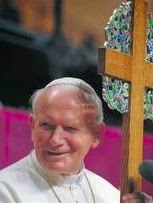 At the behest of Pope St. John Paul II, World Youth Days were held every couple of
years at rotating international locations. Skeptics certainly questioned in
disengaged youth would care about such events, but the youth loved to rally
around the Pope and open themselves to the new evangelization. The
vitality of World Youth Day tradition has not subsided in the loss of
John Paul II. These large conclaves of young people meeting to renew
their faithful inclinations echoes how John Paul II loved to channel the energy
of crowds in a positive manner to allow people to feel connected in a vibrant
and visceral way.
At the behest of Pope St. John Paul II, World Youth Days were held every couple of
years at rotating international locations. Skeptics certainly questioned in
disengaged youth would care about such events, but the youth loved to rally
around the Pope and open themselves to the new evangelization. The
vitality of World Youth Day tradition has not subsided in the loss of
John Paul II. These large conclaves of young people meeting to renew
their faithful inclinations echoes how John Paul II loved to channel the energy
of crowds in a positive manner to allow people to feel connected in a vibrant
and visceral way.[***]
While Pope Benedict XVI did not formally recognize John Paul II as a martyr in his
beatification mass, many feel that the manner in which John Paul II lived with his debilitating disease and how he died with dignity in the Vatican was exemplary. His final words were uttered in Polish "Allow me to depart to the house of the Father". John Paul II had run the good race and was not afraid to go home to the Father by extending his life through extraordinary medical procedures for terminal illness.
In addition, Pope St. John Paul II left a large body of theology during his long pontificate, which will have a long lasting influence upon the Church. [***] Many feel that Pope St. John Paul II will be best remembered for his "Theology of the Body", which was based on 129 lectures from his Wednesday audiences, which focused on Christian marriage, celibacy and virginity, contraception and the sacrament of marriage.
In Washington, DC, the new seminary has dedicated to the now Pope St. John Paul II. The John Paul II Cultural Center in Washington DC has been converted into a Church and Shrine and will be rechristened the "St. John Paul II Shrine".
Pope St. John Paul II's example of the new evangelization, his example of forgiveness and fearlessness for standing up for the faith certainly gives the model to “Be Not Afraid” in our own paths toward being part of the Community of Saints.
SEE MORE at DC-LausDeo.US
SEE MORE at DC-LausDeo.US
Wednesday, April 23, 2014
Abandonment
It 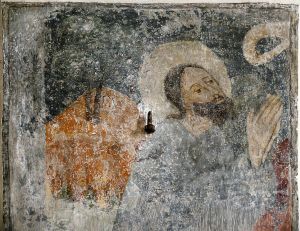 took me a long time deciding whether or not to use such an uncompromising word, but frankly I have no choice. If we really believe in God and what he has planned to do for us, has already done for us, and is doing for us now to put his plan into operation, to unite our destiny with his, then there is only one way to respond. He has chosen to give us his all, how can we do less than give our all for him.
took me a long time deciding whether or not to use such an uncompromising word, but frankly I have no choice. If we really believe in God and what he has planned to do for us, has already done for us, and is doing for us now to put his plan into operation, to unite our destiny with his, then there is only one way to respond. He has chosen to give us his all, how can we do less than give our all for him.
Read more at David Torkington
 took me a long time deciding whether or not to use such an uncompromising word, but frankly I have no choice. If we really believe in God and what he has planned to do for us, has already done for us, and is doing for us now to put his plan into operation, to unite our destiny with his, then there is only one way to respond. He has chosen to give us his all, how can we do less than give our all for him.
took me a long time deciding whether or not to use such an uncompromising word, but frankly I have no choice. If we really believe in God and what he has planned to do for us, has already done for us, and is doing for us now to put his plan into operation, to unite our destiny with his, then there is only one way to respond. He has chosen to give us his all, how can we do less than give our all for him. Read more at David Torkington
Tuesday, April 22, 2014
Learning typology with Daniel in the lions’ den
I titled this post “learning typology,” instead of “teaching typology,” because this is a subject we can adapt to any age group. Many adult Catholics are unfamiliar with typology. So if your children are grown, or you’re not a parent, read this for yourself. If you do have young children or you teach religious education, you can adapt this to your students’ ages.
If you are completely unfamiliar with typology or need a refresher course, start with my post on Teaching typology with Joseph and his brothers.
Since it is Easter, it’s a good time to look at the similarities between the prophet Daniel and Christ. The story of Daniel in the Lions’ Den prefigures Christ’s Death and Resurrection. I will go through a proposed lesson step by step for various age and skill levels.
Contineu reading at Contemplative Homeschool.
Wednesday, April 16, 2014
Some of Giving the Devil's Advocate His Due on Conspiracies and the Canonization of Pope John XXIII
In anticipation of the dual canonizations of Pope Saint John XXIII and Pope Saint John Paul II, I wanted to better understand the merits of the men whose heroic virtues the Catholic Church recognizes must be in heaven.
Contemporary memory of Pope John XXIII was that he was a portly septuagenarian Patriarch of Venice who was elected in 1958 to be a caretaker seat warmer on the Chair of Saint Peter. Yet “Papa Roncalli” audaciously called for what became the Second Vatican Council which brought the liturgy into the vernacular. “The Good Pope John” died after a pontificate of just over four years and one third of the way into Vatican II.
That thumbnail sketch of Pope John XXIII’s papacy is simplified but accurate. Yet it does not explain the apoplectic opposition from some traditional Catholics, who consider “Roncalli” an anti-pope. To better understand objections by radical traditionalist “Catholics”, I braved the fever swamps of internet intrigue, old school insider catholic baseball as well as historical peculiarities. I wanted to discern if their counter arguments were persuasive or held merit.
Those who are Sirianists strongly cling to an anomaly associated with the 1958 Conclave. The College of Cardinals were reduced to 51 electors as Pope Pius XII only held two Consistories (in 1945 and 1953) during his 19 year reign, and many of the participating Cardinals were quite elderly.
In fact two Cardinal electors died in the Interregnum prior to the Consistory so only 49 Cardinals participated. On the first evening of the Conclave, white smoke was reported coming from the Sistine Chapel indicating “Habemus Papem”. Even Vatican Radio announced: "The smoke is white... There is absolutely no doubt. A Pope has been elected." However, no Pope appeared and after perhaps twenty minutes, the smoke changed to black.
 |
| Cardinal Giuseppe Siri, Archibishop of Milan |
After votes are tallied in a Conclave, an elected is asked if he accepts the election. If so, he is asked for his desired regnal name. At that point, he is Pope. So if the Siri Thesis has merit, the Archbishop of Genoa had accepted and given the name “Gregory XVII”.
Afterwards, the vote was suppressed with threats. Yet according to the 1917 Code of Canon Law, Canon 187: "Resignation made out of grave fear that is inflicted unjustly or out of malice, substantial error, or simony is invalid by the law itself." Hence, Siri was the legitimate pope who was prevented from taking his place– Sede Impeditists– and the succeeding popes were anti-popes,. The 1958 Conclave remained deadlocked for two more days. Since Conclave proceedings are secret, conspiracy theorists string together conjecture with fragments of “facts”.
According to the intrigue, Cardinal Federico Tedeschini, an 85 year old curial cardinal, was elected as a “transitional pope” but his acceptance was immediately quashed with threats. Eventually, another transitional pope was sought, but bitter radical traditionalists bemoan that another compromise candidate the Patriarch of Venice Cardinal Angelo Roncalli, an alleged free mason, was elected Pope John XXIII on the eleventh ballot, facilitated by B'nai B'rith (Jewsish Masonic) alleged collaborator Cardinal Tisserant. Some Sede Impeditists allege that a cabal of free mason cardinals which planned a “satanic coup d’etat” to install Roncalli as the 262nd Supreme Pontiff.
[***]
As a historian, the 1958 Conclave had some interesting elements which makes one wonder. The 49 electors, with many being curial lends credence to some “palace intrigue”. Furthermore, the initial puffs of white smoke combined with confusion in the Sede Vacante Vatican on the first day of the 1958 Conclave was interesting, but inconclusive. Allegations of a fifth column or satanic coup d’etat seem like fantastic filaments in a rad/trad yarn.
[***]
Most of the radical traditional condemnations of Pope John XXIII’s reign attribute elements of change in practice (but not in doctrine) which they can not reconcile. The outreach to the Jews and the Orthodox seem anathematic to people who believe in Catholic supremacy. These radical traditionals would bristle at altering a jot or tittle of Pope St. Pius V’s one true Tridentine Missal from 1570 and would scoff at the People of God worshiping in the vernacular as they should be saying Mass in the Lord’s language of Latin (sic).
[***]
Siri intimates that he was twice elected Pope, in 1963 which he refused and for the second 1978 Conclave, which Siri supposedly was obliged to refuse to prevent a schism. Thus the source claims that Pope Paul VI and Pope St. John Paul II were anti-popes. If we choose to believe former Jesuit novelist and biblical scholar Malachi Martin, Cardinal Siri was also elected in the first 1978 Conclave. Conservative Catholics claim that Siri was elected at four conclaves but never actually assumed the Chair of St. Peter.
This sort of claim is curious. Pro arguendo, taking Cardinal Siri’s alleged claims, at face value, then what happened to his 1958 election? Cardinal Siri supposedly did not care for Pope John XXIII and despised Pope Paul VI, yet he referred to them as pontiffs. Surely a conservative Cardinal could have applied Canon Law and either disputed their elections or he could have resigned so as not to be obliged to serve under anti-popes. Yet Cardinal Siri remained as Archbishop of Genoa until 1987.
[***]
Reading plethora of scant sources of radical traditionalists on the matter, it seems that they will seize upon anything to confirm their suspicions against Modernism, Free Masonry, Internationalism (the New World Order) and even more sinister conspiracies. The sketchy sourcing calls into question their conclusions, but their contention is that Free Masons also control messaging in the Church and secular sources would not contradict their corrupted Church conspirators.
I found several striking leitmotifs in the radical traditionalist critique of “The Good Pope John”. That very moniker originates from the world-wide affection for the portly pontiff, who was able to be companions to those on the margins. No where in their literature was any good perceived from (anti) Pope John XXIII’s reign. Perhaps this should not be a great surprise as most of them condemn all Popes from 1958 onward to be anti-popes.
[***]
After reading many radical traditional assessments of the Siri Thesis and conspiracies about (anti) Pope John XXIII sound like the fare common on Art Bell’s Coast to Coast AM, which Malachi Martin was a frequent guest. These challenges to Pope John XXIII parallel conservative critiques and rejection of Vatican II longing for the days of glory epitomized in the Tridentine Mass. So questioning the authenticity of Pope John XXIII’s election by the College of Cardinals conveniently vitiate any innovations of the Council and their successors without thinking themselves as schismatic. The shifting narratives of the Siri Thesis (if one believes various sources, being elected but impeded in 1958, 1963 and twice in 1978) along with the ad hominem attacks on Pope Paul VI and Pope John Paul II sound more like sour grapes than serious charges.
[***]
Understand that radical traditionalists object to the “aggornamento” (updating) which the Second Vatican Council brought to the Catholic Church which shifted control of the Vatican from a clubby curia and failed to treat the Church like a museum. Hence, attacking the Shepherd to takes them to that place discredits him while driving home their traditionalist message.
[***]
It would behoove believers to examine the heroic virtues of Pope St. John XXIII rather than delve into Sede Impeditist and Sede Vacante fever swamps. Or as Pope St. John XXIII put it: "The habit of thinking ill of everything and everyone is tiresome to our selves and to all around us."
SEE MORE at DCBarroco.com
Tuesday, April 15, 2014
Keeping watch with Jesus--unexpectedly
 |
| Memorial to the Japanese martyrs of Unzen. (Photo by Connie Rossini.) |
This is the week for keeping watch with Jesus in a special way. Although God calls us to spend time with Him in prayer daily, we rightly feel that we should spend extra time with Him during Holy Week. But how should we go about it?
When I was a teenager, my family started a tradition of an all-night prayer vigil on Holy Thursday. Beginning at 10 p.m., my parents, siblings, and I took turns praying in one or two one-hour slots for the next eight hours. I loved offering this extra sacrifice to Jesus, this extra sign of love. Jesus would not be alone in the Garden of Gethsemane if I could help it.
After I graduated from college, I spent two years as a lay missionary in Japan, teaching English to support the evangelization work of an American priest. During spring break of the first year, my roommate Mary Beth and I traveled to the island of Kyushu. We planned to be in Nagasaki for Easter.
On Holy Thursday we were in the resort town of Unzen. Known for its hot springs, in which the Japanese bathe for health, Unzen is also the site of mass martyrdoms in the 17th century. In one of the most heinous instances of torture in history, Japanese officials hung Catholics upside-down to slowly roast over the hot springs. They punctured holes in the martyrs’ foreheads, so that the rush of blood to their heads would not kill them prematurely.
Read the rest at Contemplative Homeschool.
Subscribe to:
Comments (Atom)









.jpg)


